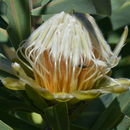pt-BR
nomes no trilho de navegação


Protea gaguedi (lat. Protea gaguedi) - proteyakimilər fəsiləsinin proteya cinsinə aid bitki növü.
Protea gaguedi (lat. Protea gaguedi) - proteyakimilər fəsiləsinin proteya cinsinə aid bitki növü.
Protea gaguedi is a species of tree which belongs to the genus Protea.[5]
This tree is known by the common name of African protea.[6][7]
Other vernacular names for this species used in South Africa include African sugarbush,[3][8][9] African white sugarbush, deciduous sugarbush or white sugarbush. In isiZulu[3] and Ndebele it is known as isiqalaba,[7] in the Northern Sotho language it is called segwapi, and in Venda tshizungu.[3] In Shona it may be called mubonda, mumhonda, or musitsuru.[7] In Afrikaans this species is known by the vernacular names of Afrika-witsuikerbos, grootsuikerbos, groot-suikerbos, suikerbos or witsuikerbos.[3]
P. gaguedi was first described as a new species by Johann Friedrich Gmelin in 1791.[2][4]
This plant usually grows in the form of a small, erect to gnarled tree,[6][9] reaching up to three metres in height.[9]
It has leaves which are oblong to elliptic, and often distinctly sickle-shaped.[6] The leaves are glabrous (hairless) when mature,[7][10] except for a few hairs near the base of the blade. The leaves are coloured light green to blue-green. The prominent midrib of the leaves is coloured somewhat yellowish.[7]
It usually has solitary flower heads, a specialised type of inflorescence.[10] These flower heads are quite variable in form,[7] but can grow up to 11 cm in diameter.[10] The flower heads are densely hairy and have a very strong scent.[7] The outer involucral bracts range in colour from pink,[7][10] to greenish-white,[10] to white. The inner bracts are covered in silver hairs and are coloured pale green. The margins of the bracts may or may not have rusty-coloured hairs sprouting from them.[7]
The fruit is a hairy nutlet.[7]
It is similar to P. welwitschii, but this species has 60mm diameter flower heads which are usually clustered together in groups of three or four, and young leaves densely covered in hairs, with older leaves retaining pubescence at their base.[10]
It is widely distributed in Africa, from Eritrea[5] in the north, to KwaZulu-Natal in South Africa.[4] It does not occur in the Sahel of West Africa.[5][11] Countries it occurs in include Sudan (including South Sudan), Eritrea,[5] Ethiopia, Burundi,[4][5] Rwanda,[4] Uganda, Kenya, Tanzania,[4][5] the Democratic Republic of Congo,[5] Zambia, Angola, Botswana, Zimbabwe, Malawi, Mozambique, Namibia, eSwatini and South Africa.[4][5]
In South Africa it is a widespread species across the north of the country, and can be found in Gauteng,[3] KwaZulu-Natal,[3][4][5][12] Limpopo, Mpumalanga and North West Province.[3]
It found in a variety of habitats, although it is often grows on rocky ground.[6]
Protea gaguedi is a widespread and common tree.[3][7]
Protea gaguedi is a species of tree which belongs to the genus Protea.
Protea gaguedi es una especie de planta fanerógama similar a Protea welwitschii y tiene hojas maduras sin pelo y cabezas de flores solitarias.
Protea gaguedi fue descrito por Johann Friedrich Gmelin y publicado en Systema Naturae . . . editio decima tertia, aucta, reformata 2: 225. 1791.[1]
Protea: nombre genérico que fue creado en 1735 por Carlos Linneo en honor al dios de la mitología griega Proteo que podía cambiar de forma a voluntad, dado que las proteas tienen muchas formas diferentes.
gaguedi: epíteto
Protea gaguedi es una especie de planta fanerógama similar a Protea welwitschii y tiene hojas maduras sin pelo y cabezas de flores solitarias.
Protea gaguedi là một loài thực vật có hoa trong họ Quắn hoa. Loài này được J.F.Gmel. miêu tả khoa học đầu tiên năm 1791.[1]
Protea gaguedi là một loài thực vật có hoa trong họ Quắn hoa. Loài này được J.F.Gmel. miêu tả khoa học đầu tiên năm 1791.